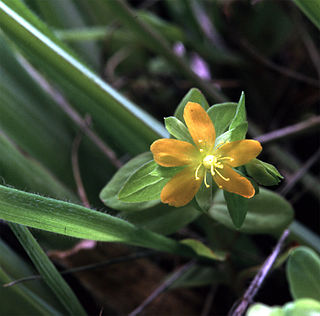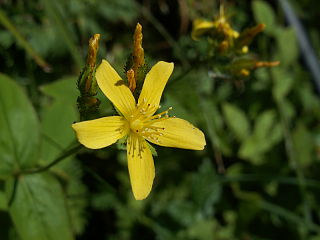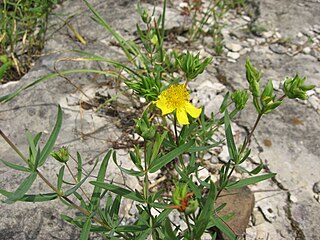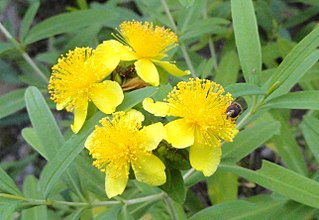
Hypericum is a genus of flowering plants in the family Hypericaceae. The genus has a nearly worldwide distribution, missing only from tropical lowlands, deserts and polar regions. Many Hypericum species are regarded as invasive species and noxious weeds. All members of the genus may be referred to as St. John's wort, and some are known as goatweed. The white or pink flowered marsh St. John's worts of North America and eastern Asia are generally accepted as belonging to the separate genus TriadenumRaf.

Hypericum calycinum is a species of prostrate or low-growing shrub in the flowering plant family Hypericaceae. Widely cultivated for its large yellow flowers, its names as a garden plant include Rose-of-Sharon in Britain and Australia, and Aaron's beard, great St-John's wort, creeping St. John's wort and Jerusalem star. Grown in Mediterranean climates, widely spread in the Strandja Mountains along the Bulgarian and Turkish Black Sea coast, and also in Flanders in Belgium.

Hypericum concinnum is a species of flowering plant known as gold-wire or goldwire. It is in the St. John's wort family, Hypericaceae. It is the only species in the section Hypericum sect. Concinna.

Hypericum anagalloides is a species of flowering plant in the St. John's wort family Hypericaceae. It is known by the common names creeping St. John's-wort, tinker's penny and bog St. John's-wort.

Hypericum maculatum, commonly known as imperforate St John's-wort, or spotted St. Johnswort, is a species of perennial herbaceous flowering plant in the family Hypericaceae. It is native to Europe and Western Asia where it grows in moist meadows.

Hypericum montanum is a plant species in the genus Hypericum commonly known as pale St. John's-wort or mountain St. John's wort. It is native to Eurasia and Morocco in North Africa.

Hypericum cumulicola is a rare species of flowering plant in the family Hypericaceae known by the common name highlands scrub hypericum, or highlands scrub St. John's wort. It is endemic to Florida, where it is threatened by habitat loss and degradation. It is a federally listed endangered species of the United States.

Hypericum dolabriforme, the straggling St. Johnswort or glade St. John's-wort, is a species of flowering plant in the St. John's wort family Hypericaceae native to the United States.

Hypericum ascyron, the great St. Johnswort or giant St. John's wort is a flowering plant in the family Hypericaceae.

Hypericum boreale, also known as northern St. John's-wort, is a short-lived perennial species of flowering plant in the family Hypericaceae, section Trigynobrathys.

Hypericum kalmianum, commonly called Kalm's St. Johns wort or Kalm's St. Johnswort, is a flowering plant in the St. John's wort family Hypericaceae. It is native to the Great Lakes region in the northern United States and southern Canada. Hypericum kalmianum was named after its discoverer, Swedish botanist Pehr Kalm (1715-1779).

Hypericum prolificum, known as shrubby St. John's wort, is a deciduous shrub in the genus Hypericum. It was named for its "prolific" number of stamens.
Hypericum edisonianum, known as Arcadian St. John's wort, Edison's St. John's wort, and Edison ascyrum, is a species of flowering plant in the St. John's wort family, Hypericaceae. It is endemic to Florida.

Hypericum tenuifolium, known as Atlantic St. John's-wort and sandhill St. John's-wort, is a species of flowering plant in the St. John's wort family, Hypericaceae. It is native to the Southeastern United States.

Hypericum suffruticosum, known as pineland St. John's-wort, is a species of flowering plant in the St. John's wort family, Hypericaceae. It is native to the Southeastern United States.
Hypericum galioides, the bedstraw St. Johnswort, is a species of flowering plant in the St. John's wort family, Hypericaceae. It is endemic to the Southeastern United States.

Hypericum tetrapetalum, the fourpetal St. Johnswort, is a species of flowering plant in the St. John's wort family, Hypericaceae. It is found in the Southeastern United States and Cuba. It was first described by Jean-Baptiste Lamarck in 1797.
Hypericum myrtifolium, the myrtleleaf St. Johnswort, is a species of flowering plant in the St. John's wort family, Hypericaceae. It is endemic to the Southeastern United States. It was first described by Jean-Baptiste Lamarck in 1797.

Hypericum virginicum, the marsh St. Johns-wort or Virginia marsh St. Johnswort, is a species of flowering plant in the family Hypericaceae. It is native to the central and eastern United States and eastern Canada.

Hypericum frondosum, the cedarglade St. Johnswort or golden St. John's wort, is a species of flowering plant in the St. John's wort family, Hypericaceae. It is native to the central and southeastern United States in dry, rocky habitats.

















